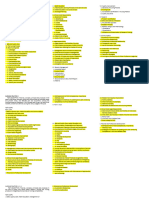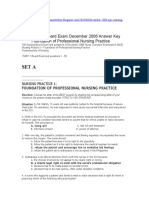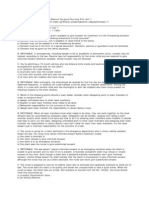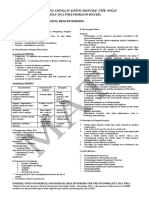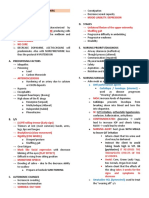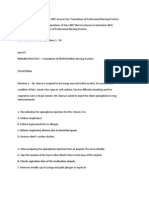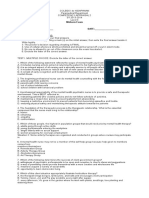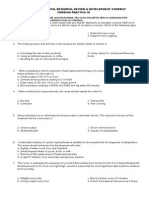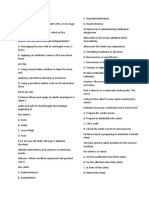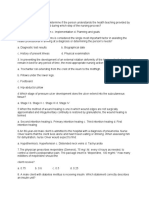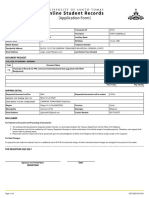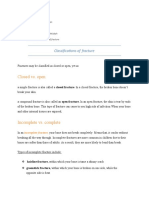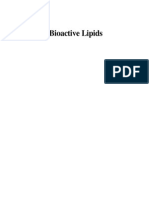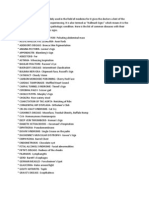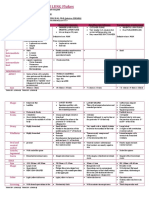NP3 (PART A SET 3): Care of the Clients with Physiologic and Psychosocial Alteration
(by Prof. Josie Quiambao- Udan)
1. Mrs. S. is a 40-year old female, and is newly diagnosed to have breast cancer stage 1. The nurse
knows this means that
a. the tumor size is less than 2 cm., no lymph node involvement.
b. the tumor size is greater than 5 cm, with axillary, supra- and infraclavicular lymph node
involvement, with extension to chest wall or skin
c. the tumor size is 2 cm. to greater than 5 cm., with axillary lymph node involvement.
d. the tumor size is greater than 5 cm., with secondary site involvement/ metastasis.
2. The following drugs are indicated for depression EXCEPT
a. Elavil
b. Pamelor
c. Prozac
d. Sinemet
3. Which of the following is a potential side effect of Codeine?
a. headache
b. drowsiness
c. diarrhea
d. hypertension
4. Mrs. B. calls the nurse to report extreme pain on her left wrist and hand. The client’s hand is swollen and
when the nurse removed the I.V. dressing, she observed a red streak along the vein and a bluish
discoloration around the IV puncture site. The following are appropriate actions by the nurse
AFTER she had stopped the infusion EXCEPT
a. Elevate the client’s arm and apply cold compress.
b. Notify the physician.
c. Assess for the presence of radial pulse and capillary refill time in her fingers.
d. Remove the peripheral catheter and apply dressings.
5. Mrs. N., a client with cancer is receiving IV fluid with incorporated Doxorubicin, a vesicant
chemotherapeutic agent. The nurse is aware that which of the following may develop at the IV site?
a. Tissue necrosis b. Extravasation c. Phlebitis d. Infiltration
6. Mr. M.’s serum calcium level is 3.5 mEq/L. Which of the following assessment data will the nurse
consider to be LEAST related to the laboratory result?
a. hypophosphatemia
b. tingling sensations on the face and around the mouth
c. abdominal cramping
d. decreased blood pressure
7. Mr. C.’s serum potassium is 2.7 mEq/ L. The physician prescribed an IV fluid of NaCl 0.9% I L with 40
mEq KCl added. The IV flow rate prescribed is 200 ml/ hr. If the maximum recommended infusion
rate is 5 to 10 mEq/ hr., which of the following nursing actions is most appropriate regarding the
physician’s prescription?
a. Do not carry out the physician’s prescription because the rate is below the recommended
infusion rate.
b. Question the physician’s order because it will overdose the patient.
c. Administer the prescribed infusion because it is within the recommended infusion rate.
d. Refer back to the physician for the clarification of recommended infusion rate.
1
� 8. Mr. K., a client with low serum potassium is hooked to a cardiac monitor. The following ECG changes
may be expected EXCEPT
a. Depressed ST- segment
b. Tall T- waves and widened QRS complex
c. prominent U- wave
d. Short T- wave
9. Mr. O., a client with MI is receiving heparin therapy. The physician orders Coumadin to be administered to
the client together with Heparin. Which of the following is the most appropriate nursing action?
a. Clarify the order.
b. Administer Heparin and Coumadin one hour apart.
c. Carry out the physician’s order.
d. Administer Coumadin after the last dose of Heparin.
10. Mr. D., a client undergoing hemodialysis has a left arm fistula. The nurse monitors the client for signs
and symptoms of Steal Syndrome which include the following:
a. warmth, redness and pain in the left arm
b. pallor, diminished pulse and pain in the left arm
c. aching pain, pallor, edema of the left arm
d. edema and purplish discoloration of the left arm
11. Mr. C., will wear crutches. An accurate measurement between the axilla and the arm pieces on the
crutches should be
a. one or two fingerwidths in the axilla space
b. two to three fingerwidths in the axilla space
c. four to five fingerwidths in the axilla space
d. five to six fingerwidths in the axilla space
12. Mrs. V., will ambulate using the 3-point crutchwalking gait. Which of the following instructions should be
given to the client
a. the crutch on one side and the opposite foot are advanced at the same time
b. the right crutch is advanced, then the left foot, then the left crutch, then the right foot
c. both crutches are advanced together, then both legs are lifted and placed down on a spot in front of the
crutches.
d. both crutches and the foot of the affected extremity are advanced together, followed by the foot of the
unaffected extremity.
2
� 13. After having assessed Abby, a child with bronchial asthma, Emergency Department Nurse Grace
documented her finding in the chart as “ examination of the chest reveals hyperresonance.” Which of the
following methods of physical examination did the nurse perform?”
a. Palpation
b. Auscultation
c. Percussion
d. Inspection
14. Mrs. R., a client experiencing neurologic manifestations will undergo lumbar puncture. The nurse will
appropriately place the client in which of the following positions?
a. lateral knee chest/fetal position
b. prone position
c. Sim’s position
d. semi-prone position
15. Nurse Toni is assigned in the Oncology Department of the hospital. The nurse has the correct
knowledge that the most accurate diagnostic test for cancer is:
a. Clinical breast examination
b. Breast Self Examination (BSE)
c. Mammography
d. Biopsy
16. In the nursing unit, Nurse Karylle noted that a person is trying to access some information from the unit
computer. Which of the following is the most appropriate action by the nurse?
a. Confront the person and stop him from getting information from the computer.
b. Report the situation to the nursing supervisor.
c. Call the security.
d. Call the police.
17. Which of the following clients is most appropriately assigned to the health aide?
a. A client who requires gastrostomy feeding.
b. A client who is anxious because of scheduled surgery
c. A client with second and third degree burns who needs bed bath.
d. A client on complete bed rest.
18. Nurse Shaina will administer Lisinopril. The nurse checks which of the following before
administration of the medication?
a. Blood pressure
b. Blood glucose level
c. Potassium level
d. BUN, Serum creatinine
3
� 19. Which of the following drugs does Nurse Vina anticipate to be administered for a client who is in pain
2 days after surgery?
a. Cogentin (Benztropine Mesylate)
b. Altace (Ramipril)
c. Valdrene (Diphenhydramine)
d. Toradol (Ketorolac)
20. Mrs. Q., a client with congestive heart failure is taking Lanoxin (Digoxin). The following are signs of
digitalis toxicity EXCEPT
a. Blurring of vision
b. Bradycardia
c. Constipation
d. Loss of appetite to eat
21. Mrs. C., developed bleeding gastric ulcer. The physician ordered insertion of nasogastric tube.
Arrange in sequence the steps of NGT insertion.
Put on gloves.
Measure length of tube to be inserted.
Place the client in High-Fowler’s position.
Secure the tube to the client’s nose with adhesive.
Insert the NGT.
Check placement of NGT.
a. 1,2,3,4,5,6 b. 3,1,2,5,6,4 c. 2,3,4,5,6,1 d. 1,3,2,5,4,6
22. During the emergent phase of burn management, Nurse Bea would anticipate which of the following
fluid and electrolyte imbalances to occur?
a. Hypokalemia, hyponatremia
b. Hyperkalemia, increased hemotocrit.
c. Decreased hematocrit, hypernatremia.
d. Hypocalcemia, increased hematocrit.
23. Mr. R., had been diagnosed to have gastroesophageal reflux disease GERD) .
Nexium(Esomeprazole Magnesium) has been prescribed. Which of the following is the desired
effect of the drug?
a. It neutralizes the gastric acid.
b. It coats ulcers in the stomach.
c. It reduces gastric acids secretions.
d. It reduces gastric motility.
24. Which of the following Insulin preparation is long- acting insulin?
a. Humulin – R c. Humulin - N
b. Lispro (Humalog) d. Humulin - U
25. Which of the following is the indication of Zyloprim?
a. Inhibit uric acid production. c. Relieve inflammation
b. Increase urinary excretion of uric acid. d. Relieve pain
26. Which of the following is an indication of Acyclovir (Zovirax)?
a. Herpes Simplex c. Impetigo
b. Gonorrhea d. Scarlet fever
27. Nizoral (Ketoconazole) tablet is taken by the client with Candidal skin infection. Which of the following
health teachings should be given to the client? Select all that apply.
1. Avoid taking alcohol.
2. Report dark urine, yellow coloring of the skin and whites of the eyes.
3. You may discontinue taking the medication once the lesions on the skin are gone.
4
� 4. You may stop taking the medication if you experience rashes, pruritus and inform your
physician.
5. Take the medication on empty stomach.
a. 1,2,4 b. 1,2,4,5 c. 3,4,5 d. all of the above
28. Which of the following is an indication for Amaryl?
a. Allergy c. Diabetes Mellitus
b. Migraine d. Hypertension
29. Mrs. G., a client with diabetes mellitus has a blood glucose level of 60 mg/dL. Which of the following
signs and symptoms does the nurse observe in the client?
a. Urine output of 300 mls. In 2 hours. c. Warm, flushed dry skin
b. Impaired mental alertness, dizziness. d. Deep rapid breathing
30. Dior, an ICU nurse is assigned to care for a client who is in shock state. The nurse is aware that a
situation that is common to all types of shock is
a. BP of 90 mmHG and heart rate greater than 100 bpm
b. Decreased oxygen delivery to tissues with decreased oxygen consumption.
c. Loss of blood
d. Impaired oxygen delivery with increased oxygen consumption.
31. Which of the following signs and symptoms of Mrs. T., a client with Parkinson’s disease should be
reported by the nurse to the physician?
a. Tiptoe walking
b. Drooling of saliva
c. Headache, dizziness
d. Slow movement
32. Mr. D., a client with Parkinson’s disease was given Symmetrel (Amantadine). Which of the following
findings indicate effectiveness of the medication? Select all that apply.
Reduced muscular rigidity.
Improvement of tremor of head and hands.
Able to tolerate mechanically soft diet.
Holds cup of coffee without spilling the fluid.
Able to do tiptoe walking.
a. 1,2,3,4 b 2,3,4,5 c. 1,3,4,5 d. all of the above
33. Mrs. S., a client with breast cancer is prescribed Tamoxifen 20 mg P.O. B.I.D. She complains to the
nurse that she has worsening bone pain. Which of the following is the best response by the nurse?
a. “ I’ll get you something for pain immediately.”
b. “ I’ll notify your physician immediately if he wants to change your treatment plan.”
c. “ Acute worsening of bone pain commonly indicates that the drug will produce a good response.”
d. “ I’ll withhold the next dose and will see if your bone pain lessens.”
34. Which of the following foods should be included in the diet of Mr. Giessler, a client who is experiencing
alcoholism?
a. Foods rich in Vitamin A.
b. Foods rich in Vitamin C.
c. Foods rich in Vitamin K.
5
� d. Foods rich in Vitamin B.
35. Mr. C., has been diagnosed to have Adrenal insufficiency. He is on Florinef (Fludrocortisone) therapy.
Which of the following statements by the patient needs intervention by the nurse?
a. “I need to stop taking the pill if I gain too much weight.”
b. “I need to include fruits and vegetables in my diet.”
c. “I need to take calcium supplement.”
d. “I need to monitor my blood pressure.”
36. Nurse Romina appropriately decides that the most important patient outcome for a client in shock with
a nursing diagnosis of decreased cardiac output related to hypovolemia is
a. oxygen saturation of 90% or more
b. urine output of 0.5 ml/kg/ hour
c. decreased peripheral edema
d. decreased central venous pressure (CVP)
37. The ABG results show that Mr. P. has pH of 7.50 PaCO2 of 30. Which of the following is an
appropriate nursing intervention?
a. Instruct the client to breath into a paper bag.
b. Administer oxygen therapy.
c. Monitor the client for hyperkalemia
d. Perform postural drainage after breakfast.
38. Dr. Cuenca, a physician has asked for intravenous calcium to treat a client with hyperkalemia. What is
the nurse’s first response?
Hand the physician calcium chloride for intravenous use.
Check with the physician for his complete order.
Hand the physician calcium gluconate for intravenous use.
Hand the physician the kind of calcium available on the unit.
39. Mr. L. had undergone thoracostomy has a 3-bottle chest drainage system. The nurse caring for the
client observes intermittent bubbling in the water seal bottle . The nurse correctly evaluates this as
a. re- expansion of the lungs.
b. presence of air leak.
c. obstruction of connecting tubings.
d. patent chest tube.
40. Mr. G. had been diagnosed to have diabetes insipidus. The following findings are expected in the
client EXCEPT
a. High blood glucose levels.
b. Increased hematocrit.
c. Increased urine output.
d. Decreased urine specific gravity.
41. Which of the following clients in the psychiatric unit should Nurse Julia see first?
a. A client with major depression who refuses to eat.
b. A client pacing back and forth with angry facial expression.
c. A client who performs handwashing 50 times a day.
d. A client who is talking alone and calling the wall “Henry”
42. Which of the following is a true statement about a 5 year old child’s view on death in the family.
a. The child believes that the dead parent will be away for sometime.
b. The child feels responsible or feels like, it is his fault that a parent died.
c. The child views the dead parent to be sleeping.
d. The child perceives that death can be defied.
43. Mr. Gil is on Norvasc (Amlodipine) therapy. Which of the following statements by the client indicates
understanding of health teachings about the medication?
a. “I will take these pills until I feel better.”
b. “I will stop taking these pills if I experience headache or dizziness.
6
� c. “I will continue taking these pills even when symptoms disappear.”
d. “I will take these pills until my blood pressure is controlled.”
44. Which of the following assessment data in Mr. A., a male client on septic shock will be of greatest
concern to the nurse caring for him?
a. Urine output is 15 ml for 2 hours
b. Arterial oxygen saturation 86%
c. BP 90/ 50 mmHg
d. Apical pulse 112/ min
45. The following are true when giving medications EXCEPT
a. ASA can be given with Coumadin.
b. Coumadin can be given with Heparin.
c. Aquamephyton is given when a client on Coumadin experiences bleeding.
d. Naloxone is given when the patient who has received Meperidine experiences respiratory
depression.
46. Mrs. Z., a pregnant client is asking the nurse on which of the following foods have high calcium
content. Which of the following is the most appropriate response? Select all that apply.
1. Cabbage
2. Oysters
3. Cheese
4. Tofu
5. Milk
A. 2,3,5 B. 2,3,4,5 C. 1,2,3,4,5 D. 1,2,3
47. Mrs. G., a client with severe depression had undergone ECT. Which of the following is expected after
ECT?
a. Temporary memory loss.
b. Elevation of blood pressure.
c. Lowering of body temperature.
d. Depression
48. Which of the following effects will be produced if Furosemide was added to the treatment of a client in
septic shock?
a. decreased urine output
b. increased blood pressure
c. increased urine output
d. increased myocardial oxygen demand
49. Mr. G., a boxer is taking Motrin (Ibuprofen). Which of the following statements by the client should
concern the nurse most?
a. Client states that he will take the medication with milk.
b. Client states that he will avoid taking ASA.
c. Client states that he has clay colored stool.
d. Client states that he will avoid driving if he feels dizzy.
50. Mr. Dee, had been diagnosed to have acute pancreatitis. Which of the following manifestations should
be reported by the nurse to the physician.
a. Fatty stools
b. Elevated serum amylase
c. Tingling of mouth and lips.
d. Nausea and vomiting.
7
� 51. Mr. C. had been diagnosed to have MI. Which of the following laboratory findings is most accurate
indicator of cardiac muscle damage?
a. Elevated Troponin T and I
b. Elevated Serum Alkaline Phosphatase
c. Elevated AST and ALT
d. Elevated Creatine Phosphokinase (CPK)
52. Nurse Ava is administering an intravenous potassium chloride (KCL) supplement to a client who has
congestive heart failure. When developing a plan of care for this client, the nurse should incorporate the
following into the care plan EXCEPT
a. Hypokalemia will intensify the action of the client’s digitalis preparation.
b. The client’s potassium levels will be affected by his potassium-sparing diuretic.
c. The administration of the intravenous potassium chloride should not exceed 10mEq/hour or a
concentration of 40mEq/L.
d. Metabolic alkalosis will increase the client’s serum potassium levels.
53. Mr. S., a client with liver cirrhosis is experiencing hepatic encephalopathy. Which of the following
medications should be administered by the nurse first?
a. Aldactone (Spironolactone) for ascites.
b. Atarax (Hydroxyzine) for pruritus.
c. Lactulose for expelling ammonia from the colon.
d. Vasopressin for stimulating peristalsis.
54. Which of the following is an effect of garlic?
a. It elevates HDL.
b. It promotes blood clotting.
c. It relieves chest pain.
d. It lowers BP.
55. Which of the following assessment is normal in Mackie, a 5- year old child?
a. Concerned with social and political problems.
b. Has a vocabulary of 2,100 words.
c. Experiences feeling of “being in love” with the opposite sex parent
d. Repeats days of the week and months in order.
56. An order for medication is to administer 100mcg. The available stock is 100mcg/ml. How many ml. will
Nurse Aria administer?
a. 1 ml b. 0.1 ml c. 10 ml d. 100 ml
57. Mrs. L. has been diagnosed to have AIDS. Which of the following clients may be roomed-in with this
client?
a. The client with pneumonia.
b. The client with Clostridium Difficile Infection.
c. The client with Human Immunodeficiency virus (HIV) Infection.
d. The client with Shigellosis
58. Mrs. H., a client with diabetes mellitus developed diabetes ketoacidosis. Which of the following results of
laboratory tests should Nurse Carlota expect? Select all that apply.
1. Elevated serum glucose
2. Increased acidity
3. Low carbon dioxide
4. High carbon dioxide
5. Glycosuria
a. 1,2,3,5 b. 1,2,4,5 c. 3,4,5 d. all of the above
8
�59. Mrs. A., a client with diabetes mellitus had self-injected regular insulin. She omitted her breakfast
because she was already late for work. Which of the following assessments are indicative of hypoglycemic
reaction to insulin?
a. Pallor, diaphoresis, tremors.
b. Dry, flushed skin, excessive urination.
c. Glycosuria, abdominal pain, excessive thirst.
d. Weakness, altered level of consciousness, fruity odor of breath.
60. Immediately following thyroidectomy, Mrs. Agatha should be monitored for the following signs of postop
complications?
1. increased BP.
2. signs of respiratory obstruction.
3. severe hoarseness of voice.
4. elevated body temperature.
5. carpal spasm
a. 1,2,3 b. 3,4,5 c. 1,3,5 d. all of the above
9
�61. Which of the following is an indication of Aricept?
a. Parkinson’s disease
b. Alzheimer’s Disease
c. Myasthenia Gravis
d. Schizophrenia
62. Nurse Erich will administer Digoxin per gastrostomy tube. Arrange in sequence the following nursing
actions when performing the procedure.
1. Check the apical pulse for 1 minute.
2. Flush the gastrostomy tube with 15-30ml. water.
3. Administer the medication.
4. Place the client in Semi-Fowlers position.
a.1,2,3,4 b. 4,3,2,1 c. 1,4,3,2 d.1,4,2,3
63. Nurse Anne is caring for a client who is newly diagnosed to have breast cancer. Which of the following
responses of the client indicates that she is in the denial stage of the diagnosis of breast cancer?
a. Calmly talking with a breast cancer support group member.
b. Seriously expressing her feelings about the plan of treatment.
c. Cheerfully discussing the party she last attended.
d. Requesting more information about prostheses.
64. Mr. B., a client diagnosed to have Schizophrenia refuses to take medications daily. Which of the
following medications does the nurse expect to be prescribed for the patient?
a. Elavil
b. Prolixin
c. Tofranil
d. Geodon
65. Mrs. G., a client newly diagnosed with chronic renal failure has begun hemodialysis. The nurse monitors
the client for signs and symptoms of disequilibrium syndrome which include the following:
a. hypertension, bradycardia, bradypnea
b. hypotension, bradycardia, hypothermia
c. restlessness, irritability, tachycardia
d. headache, deteriorating level of consciousness and tachypnea
66. Mr. J. had undergone myelography using Metrizamide contrast medium. The nurse appropriately places
the client in which of the following positions after the procedure?
a. supine position
b. Semi-Fowler’s position
c. slight Trendelenburg position
d. High-Fowler’s position
67. Mr. P. had been diagnosed to have Grave’s disease. The nurse monitors the client for which of the
following signs and symptoms?
a. fatigue, dry hair, brittle nails
b. hypertension, weight loss, anorexia
c. obesity, hypertension, tachycardia
d. hypocalcemia, exophthalmos, increased appetite to eat
68. Which of the following clients should be given highest priority by Nurse Bernadette?
a. The client who needs to take Nitroglycerine for chest pain.
b. The client who needs Tranxene (Chlorazepate) for panic attack.
c. The client who needs Lasix (Furosemide)for ascites.
d. The client who needs Lopressor(Metoprolol) as maintenance dose for hypertension.
10
�69. Mrs. R., a client with Parkinson’s disease is taking Cogentin. Which of the following are side effects of
the medication. Select all that apply.
1. abdominal cramps 4. nausea and vomiting
2. hypertension 5. urinary retention
3. constipation 6. miosis
a. 2,3,4,5 b. 1,4,5,6 c. 1,3,4,6 d. all of the above
70. Mr. U., a client with Parkinson’s disease is on Sinemet (Carbidopa with Levodopa therapy). Which of the
following foods should be avoided by the client. Select all that apply.
1. Cheddar cheese 4. Soy sauce
2. Beer 5. Chocolate
3. Chicken liver 6. Sausage
a.1,2,3,6 b.2,3,4,5 c. 3,4,5,6 d. all of the above
71. Mr. F., a client with elevated serum cholesterol and triglycerides is taking Zocor (Simvastatin). Which of
the following health teachings should be provided to the patient? Select all that apply.
1. Take the medication in the evening.
2. Avoid taking the medication with Niaspan (Nicotinic acid)
3. Avoid taking large quantities of grapefruit juice.
4. Take the medication one hour before meal.
5. Take the medication after meal.
6. Report to the physician muscle tenderness and weakness.
a.3,4,6 b. 1,2,5,6 c. 1,2,3,5,6 d. 2,3,5,6
72. Dr. Cruz ordered Pilocarpine eye drop for a client with glaucoma. Which of the following is the most
appropriate action by the nurse?
a. Clarify the physician’s order. c. Refuse to carry out physician’s order.
b. Carry out the physician’s order. d. Verify the order with the nurse supervisor.
73. Which of the following is true in the purpose of Megace (Megestrol) for a client with breast cancer or
endometrial cancer?
a. To prevent hair loss. c. To relieve nausea and vomiting.
b. To treat loss of appetite to eat or malnutrition. d. To protect from infection.
74. Mrs. C. has ileostomy. Low fiber diet is recommended. Which of the following foods are appropriate for
the client? Select all that apply.
1. white rice
2. hard boiled eggs
3. ripe banana
4. steamed fish
5. cooked carrots
a. 1,2,4,5 b. 1,3,4,5 c. 1,2,3,4,5 d. 1,2,3,5
75. Which of the following is appropriate nursing intervention for a jaundiced male newborn during
phototherapy?
a. Place the newborn on side – lying position.
b. Cover genitals to protect from heat.
c. Wrap the newborn during phototherapy.
d. Cover the newborn’s eyes intermittently.
76. Mr. C. had left cerebrovascular accident (CVA). Which of the following is correct understanding on
holding the cane by the patient?
a. The client holds the cane with the right hand.
b. The client holds the cane with the left hand.
c. The client holds the cane alternately with the right and left hand.
d. The client is not allowed to use cane.
11
�77. Which of the following method of oxygen delivery gives the most accurate amount of oxygen?
a. partial rebreathing face mask c. venturi mask
b. nasal cannula d. non – rebreather mask
78. Mr. A had been diagnosed to have Syndrome of inappropriate anti – diuretic hormone (SIADH). The
following nursing interventions are appropriate for the client EXCEPT
a. increase fluid intake
b. administer diuretic as ordered
c. decrease fluid intake
d. administer sodium – containing IV fluids as prescribed
79. Mrs. D. had been diagnosed to have chronic pancreatitis. Which of the following signs and symptoms
indicate that a complication has occurred?
a. bile – stained vomitus c. periumbilical purplish discoloration
b. steatorrhea d. elevated serum amylase
80. Which of the following is the most appropriate nursing intervention to prevent hypothermia in a 3 – day
old infant?
a. Dry and wrap the infant quickly after bath. c. Place the infant in a radiant warmer.
b. Set room temperature to 61 F. d. Wash only the face and genitals of the
infant.
81. Mr. A., a client with chronic renal failure is undergoing peritoneal dialysis. He asks why the nurse
monitors his blood glucose levels. Which of the following will be the most appropriate response by the
nurse?
a.”I have to check if you have diabetes mellitus.”
b. “The dialysate contains glucose.”
c. “The procedure may lower your blood glucose levels.”
d. “It is a routine procedure for every client who undergoes the treatment.”
82. Mrs. G. had been diagnosed to have diabetes mellitus type II. Which of the following signs and
symptoms may be experienced by the client? Select all that apply.
1. polyuria
2. excessive thirst
3. weight loss
4. obesity
5. excessive hunger
6. urine sp gr 1.002
a. 1,2,4,6 b. 1,2,3,5 c. 1,2,4 d. 1,2,4,5
83. Which of the following is most appropriate nursing intervention for a client with closed head injury?
a. Elevate the client’s head at 15 degrees. c. Administer narcotic analgesic.
b. Administer stool softener as prescribed. d. Encourage deep breathing and coughing
exercises.
84. Mr. MJ has left homonymous hemianopsia. Nurse Bianca needs to intervene in which of the following
situations?
a. The client wears eyeglasses. c. The telephone is placed within patient’s reach.
b. The spouse approaches the client on the right side. d. The call light is placed on the left side of the client.
85. The following are appropriate actions by Nurse Kris when caring for a client with Parkinson’s disease
EXCEPT
a. Give adequate time for the client to finish activities.
b. Allow the client to perform ADL (activities of daily living) within his capabilities.
c. Provide diversional activities like putting beads on a string.
d. Provide the client family photo albums.
12
�86. The following are important infection control practice for Mrs. I., a client with Neisseria meningitides
meningitis Except
a. Provide a private room.
b. Wear surgical mask, gown and gloves when entering the client’s room.
c. Wash hands before and after coming in contact with the client.
d. The client wears mask while in his room.
87. Nurse D. is on Isotretinoin for severe acne. Which of the following drugs should not be taken by the
client?
a. Tetracycline c. Calcium supplement
b. Contraceptive pills d. Metropolol
88. Mr. G. had been diagnosed to have Metabolic Syndrome. Which of the following manifestations
characterize the condition? Select all that apply.
1. abdominal obesity 4. elevated HDL
2. elevated triglycerides
3. elevated LDL
a.1,2, b. 1,2,3 c.1, 2,3,4 d. 1,3,4
89. Who among these clients is prone to hepatitis C?
a. The client who undergoes lifelong hemodialysis.
b. The client who has hepatitis B.
c. The client who frequently eats in restaurants.
d. The client who is an informal urban settler.
90. Mrs. R. had been diagnosed to have macular degeneration. Which of the following is an appropriate
nursing action when approaching the client?
a. Stay directly in front of the client. c. Approach the client from his back.
b. Approach the client from his side. d. Stay on the right side of the client.
91. Mrs. R., a client for intermittent self-catheterization is concerned with the cost of materials for the
procedure. Which of the following is the most appropriate response by the nurse?
a. “I will refer you to social welfare department.”
b. “You should be more concerned with your health rather than the cost of materials.”
c. “The materials can be reused if properly cleaned and safely kept.”
d. “You better discuss your concern with your primary health care provider.”
92. Mr. P., had been diagnosed to have COPD. The following assessment findings should are expected by
the nurse EXCEPT
a. Oxygen saturation of 91%. c. RBC level of 6 million/cu. mm.
b. WBC level of 13,000/cu. mm. d. Blood pH of 7.32.
93. Nurse G. will instill eardrops to the adult client. Arrange in sequence the following steps when
performing the procedure.
1. Straighten the auditory canal by pulling the pinna upward and backward.
2. Have the client sit or lie down with head turned to the unaffected ear.
3. Instill medication on the side of the auditory canal.
4. Release the pinna, gently massage the tragus of the ear.
a. 2,1,3,4 b. 1,2,3,4 c. 4,3,2,1 d. 3,4,1,2
94. Mrs. B. had undergone barium enema (lower GI series). Which of the following is expected after the
procedure?
a. The client’s stools are white. c. The client’s pulse rate is 50 bpm.
b. The client experiences diarrhea. d. The client experiences dizziness.
95. Which of the following diseases is characterized by “bull’s eye/ target rash”?
a. Lyme disease c. Shingles
b. Psoriasis d. Rubeola
13
�96. Which of the following laboratory values is expected in a client with SIADH?
a. serum potassium is 3.2 mEq/L. c. serum sodium is 118 mEq/L.
b. serum calcium is 4 mEq/L. d. serum magnesium is 1.3 mEq/L.
97. Nurse Charles will trim the toenails of an elderly patient. Arrange the sequence of nursing actions when
performing the procedure.
1. Trim the toenails 3. File the toenails.
2. Soak the feet of the patient in warm water 4. Wipe the patient’s feet gently
a. 1,2,3,4 b.3,1,2,4 c. 2,4,1,3 d. 4,3,2,1
98. Mr. F. had been diagnosed to have cholelithiasis. He had undergone laparoscopic cholecystectomy.
Which of the following does the nurse recognize as normal signs and symptoms after the surgery?
a. Abdominal pain and bloating.
b. Diminished lung sounds.
c. Bile-stained vomitus.
d. Hyperactive bowel sounds.
99. Mr. R., a client who had undergone thoracic surgery 2 hours ago has chest tube connected to water –
seal drainage in place. Which of the following needs intervention by the nurse?
a. There is continuous bubbling in the water – seal chamber.
b. The drainage from the chest tube is bloody.
c. The suction control chamber is filled with 20 cm. sterile normal saline solution.
d. The airvent is uncapped.
100. The nurse incorporates which priority nursing intervention into a plan of care to promote sleep for a
hospitalized patient?
a. Have patient follow hospital routines.
b. Avoid waking the patient for nonessential tasks
c. Give prescribed sleeping medication at dinner.
d. Turn television on low to late- night programming.
You’re on your way towards success future Thomasian RNs……..
jqu
14


